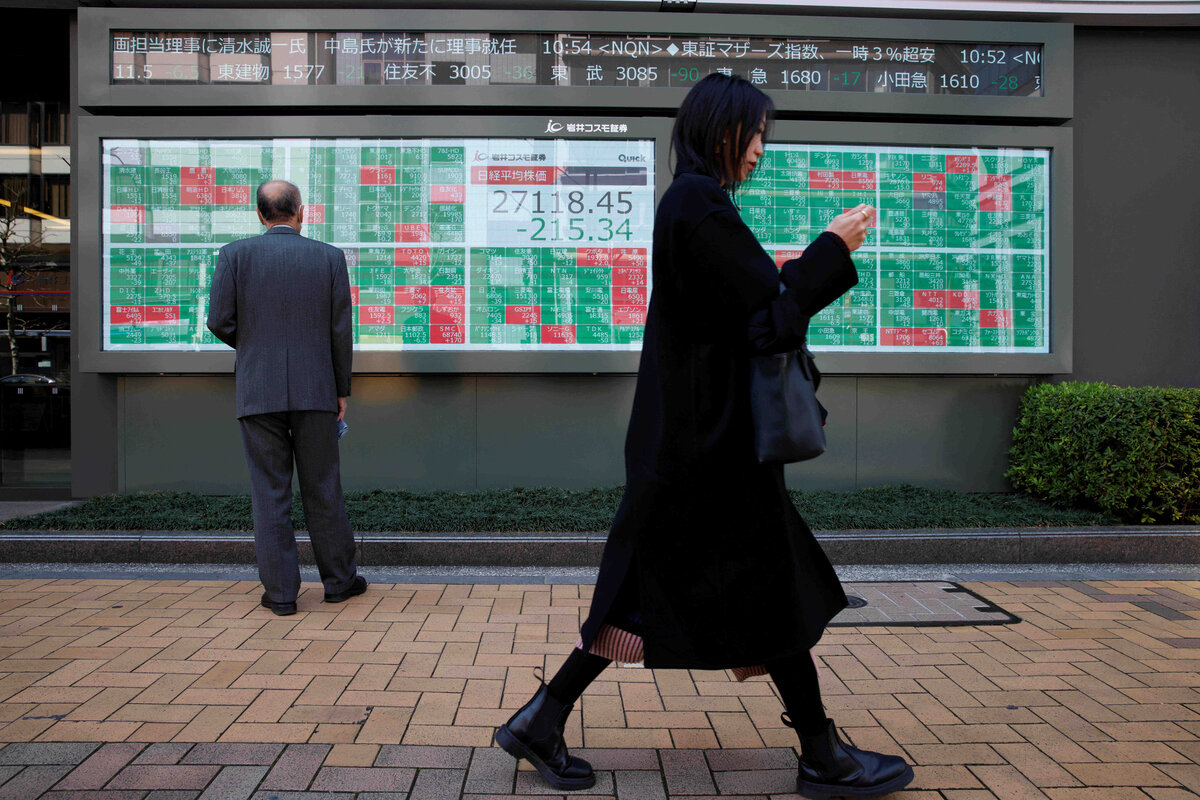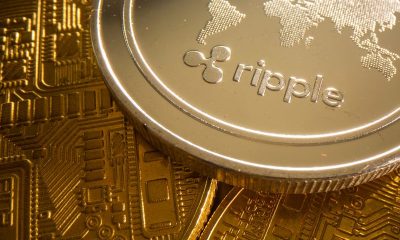Economy
Global shares edge up as Fed pause bets bolster sentiment

Global equities were set for a small weekly gain on Friday following a Wall Street rally overnight, as rising bets the Federal Reserve will skip a rate increase next week overshadowed worries about U.S. markets being drained of cash.
MSCI’s broad index of global shares edged 0.2% higher, on track for a weekly rise of 0.6%.
Europe’s Stoxx 600 equity gauge was flat, following a 2% jump in Japan’s Nikkei, which rebounded strongly after its plunge from a 33-year high in the previous session.
Traders now lay 73% odds on the Fed keeping rates steady on June 14, in a range of 5%-5.25%, pausing its most aggressive hiking cycle since the 1980s.
Bets for a pause were supported by data overnight showing the number of Americans filing new jobless claims surged to a more than 1 1/2-year high, indicating a loosening labour market that could further quell inflation.
Investors also hope the Fed will pause its rate rise campaign as a quirk of the U.S. debt ceiling negotiations has posed a potential a threat to market liquidity.
The U.S. government is expected to rush to sell short term debt to replenish its Treasury General Account, potentially at yields so high that banks raise deposit rates to compete for funding, reducing interest in riskier assets like equities.
“We’re all worried about liquidity,” said Ben Jones, director of macro research at Invesco. The Fed, he added, “still wants to tighten,” policy and therefore may allow the TGA rebuild to drain liquidity from markets without stepping in to provide other support tools.
This fear was not dominating trading on Friday, however.
On Wall Street overnight, gains were led by the tech-heavy Nasdaq, which surged 1.27%.
The broader S&P 500 rose 0.62%. Its gains put the benchmark index up 20% from its Oct. 12 closing low and heralded the start of a new bull market, at least by the definition of some market participants.
On Friday, e-mini U.S. equity futures pointed to a steady start for each of the indices.
Fed Chair Jerome) said on May 19 it was still unclear if U.S. interest rates will need to rise further, and the risks of overtightening or undertightening had become more balanced.
YIELDS UP
Two-year Treasury yields, which are extremely sensitive to monetary policy expectations, rose about 3.5 basis points (bps) to around 4.55%. The 10-year yield edged up to 3.749% after tumbling 7 bps overnight.
The U.S. dollar index, which measures the currency against a basket of six major peers, rebounded 0.2% to 103.52.
The euro slipped 0.15% to $1.0765, just below Thursday’s two-week high of $1.0787.
Elsewhere, the Turkish lira extended its decline to a new record low of 23.5 per dollar, even as President Tayyip Erdogan’s appointment of a U.S. banker as central bank chief sent a strong signal for a return to more orthodox policy.
Erdogan had last week put well-regarded former finance minister Mehmet Simsek back in the post. Simsek said this week that the guiding principles for the economy would be transparency, consistency, accountability and predictability.
Leading crypto asset bitcoin briefly dipped before recovering to trade 0.5% firmer at $26,637 after crypto exchange Binance said it was suspending dollar deposits and would soon pause fiat currency withdrawal channels following a U.S. Securities and Exchange Commission crackdown.
Crude oil remained on the back foot after a report that the United States and Iran were close to a nuclear deal, although denials from both parties kept it off the previous session’s lows.
The prospect of a deal, which reportedly includes scope for an additional 1 million barrels per day of Iranian production, had knocked down West Texas Intermediate (WTI) crude by $3.50 to just shy of $69 at one point on Thursday.
WTI futures fell 0.3% to $71.09. Brent crude futures were off by the same amount at $75.75.
Economy
Russian central bank says it needs months to make sure CPI falling before rate cuts -RBC


© Reuters. Russian Central Bank Governor Elvira Nabiullina attends a news conference in Moscow, Russia June 14, 2019. REUTERS/Shamil Zhumatov/File Photo
MOSCOW (Reuters) – Russia’s central bank will need two to three months to make sure that inflation is steadily declining before taking any decision on interest rate cuts, the bank’s governor Elvira Nabiullina told RBC media on Sunday.
The central bank raised its key interest rate by 100 basis points to 16% earlier in December, hiking for the fifth consecutive meeting in response to stubborn inflation, and suggested that its tightening cycle was nearly over.
Nabiullina said it was not yet clear when exactly the regulator would start cutting rates, however.
“We really need to make sure that inflation is steadily decreasing, that these are not one-off factors that can affect the rate of price growth in a particular month,” she said.
Nabiullina said the bank was taking into account a wide range of indicators but primarily those that “characterize the stability of inflation”.
“This will take two or three months or more – it depends on how much the wide range of indicators that characterize sustainable inflation declines,” she said.
The bank will next convene to set its benchmark rate on Feb. 16.
The governor also said the bank should have started monetary policy tightening earlier than in July, when it embarked on the rate-hiking cycle.
Economy
China identifies second set of projects in $140 billion spending plan


© Reuters. FILE PHOTO: Workers walk past an under-construction area with completed office towers in the background, in Shenzhen’s Qianhai new district, Guangdong province, China August 25, 2023. REUTERS/David Kirton/File Photo
SHANGHAI (Reuters) – China’s top planning body said on Saturday it had identified a second batch of public investment projects, including flood control and disaster relief programmes, under a bond issuance and investment plan announced in October to boost the economy.
With the latest tranche, China has now earmarked more than 800 billion yuan of its 1 trillion yuan ($140 billion) in additional government bond issuance in the fourth quarter, as it focuses on fiscal steps to shore up the flagging economy.
The National Development and Reform Commission (NDRC) said in a statement on Saturday it had identified 9,600 projects with planned investment of more than 560 billion yuan.
China’s economy, the world’s second largest, is struggling to regain its footing post-COVID-19 as policymakers grapple with tepid consumer demand, weak exports, falling foreign investment and a deepening real estate crisis.
The 1 trillion yuan in additional bond issuance will widen China’s 2023 budget deficit ratio to around 3.8 percent from 3 percent, the state-run Xinhua news agency has said.
“Construction of the projects will improve China’s flood control system, emergency response mechanism and disaster relief capabilities, and better protect people’s lives and property, so it is very significant,” the NDRC said.
The agency said it will coordinate with other government bodies to make sure that funds are allocated speedily for investment and that high standards of quality are maintained in project construction.
($1 = 7.1315 renminbi)
Economy
Russian central bank says it needs months to make sure CPI falling before rate cuts -RBC


© Reuters. Russian Central Bank Governor Elvira Nabiullina attends a news conference in Moscow, Russia June 14, 2019. REUTERS/Shamil Zhumatov/File Photo
MOSCOW (Reuters) – Russia’s central bank will need two to three months to make sure that inflation is steadily declining before taking any decision on interest rate cuts, the bank’s governor Elvira Nabiullina told RBC media on Sunday.
The central bank raised its key interest rate by 100 basis points to 16% earlier in December, hiking for the fifth consecutive meeting in response to stubborn inflation, and suggested that its tightening cycle was nearly over.
Nabiullina said it was not yet clear when exactly the regulator would start cutting rates, however.
“We really need to make sure that inflation is steadily decreasing, that these are not one-off factors that can affect the rate of price growth in a particular month,” she said.
Nabiullina said the bank was taking into account a wide range of indicators but primarily those that “characterize the stability of inflation”.
“This will take two or three months or more – it depends on how much the wide range of indicators that characterize sustainable inflation declines,” she said.
The bank will next convene to set its benchmark rate on Feb. 16.
The governor also said the bank should have started monetary policy tightening earlier than in July, when it embarked on the rate-hiking cycle.

 Forex3 years ago
Forex3 years agoForex Today: the dollar is gaining strength amid gloomy sentiment at the start of the Fed’s week

 Forex3 years ago
Forex3 years agoUnbiased review of Pocket Option broker

 Forex3 years ago
Forex3 years agoDollar to pound sterling exchange rate today: Pound plummeted to its lowest since 1985

 Forex3 years ago
Forex3 years agoHow is the Australian dollar doing today?

 Cryptocurrency3 years ago
Cryptocurrency3 years agoWhat happened in the crypto market – current events today

 World3 years ago
World3 years agoWhy are modern video games an art form?

 Commodities3 years ago
Commodities3 years agoCopper continues to fall in price on expectations of lower demand in China

 Economy3 years ago
Economy3 years agoCrude oil tankers double in price due to EU anti-Russian sanctions



























